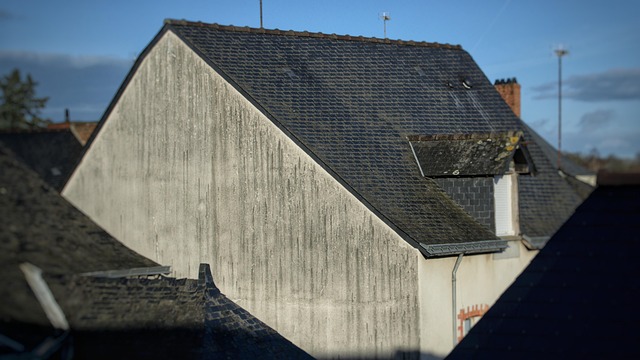Flat roof leaks pose challenges due to complex entry points, aging materials, improper installations, or environmental factors. Flat roof services professionals offer expert leak detection and repair solutions using high-quality tar, asphalt cement, and specialized membranes. A systematic approach, including thorough inspection, gathering essential tools and materials, and a structured repair process, ensures effective DIY repairs. Regular maintenance through inspections, ventilation checks, and gutter cleaning further prevents future leaks, extending the lifespan of flat roofs.
Flat roofs are a popular choice for residential and commercial properties, offering cost-effective and low-maintenance solutions. However, they are prone to leaks, which can cause significant damage if left unaddressed. This article provides an in-depth guide to repairing leak-prone flat roofs. From identifying common causes like missing or damaged shingles, flashing issues, and age-related deterioration, to offering a step-by-step patching and replacement process, we equip you with the knowledge for efficient repairs. Learn preventive measures too, ensuring your flat roof remains leak-free with expert flat roof services.
- Understanding Flat Roof Leaks: Common Causes and Entry Points
- Essential Tools and Materials for Efficient Repairs
- Step-by-Step Guide: Patching and Replacing Damaged Areas
- Preventive Measures: Strengthening Your Flat Roof Against Future Leaks
Understanding Flat Roof Leaks: Common Causes and Entry Points
Flat roof leaks can be frustrating and costly, but understanding their common causes is the first step towards effective repairs. These leaks often arise from various entry points in the roof’s structure, such as joints, seams, or areas around fixtures like vents and pipes. The flat design makes it challenging to identify and access these problem spots, exacerbating the issue.
One of the primary reasons for flat roof leaks is aging and degradation of materials, including broken or missing shingles, damaged flashing (the waterproof material around openings), and worn-out seals. Other factors include improper installation, poor drainage systems causing water accumulation, and environmental conditions like heavy rain, snow, or extreme temperatures. Flat roof services professionals must thoroughly inspect these areas to pinpoint the exact cause, ensuring long-lasting repairs.
Essential Tools and Materials for Efficient Repairs
When tackling repairs for a leak-prone flat roof, having the right tools and materials is crucial for efficient and long-lasting solutions. For any flat roof services, a well-stocked toolkit should include high-quality tar, asphalt cement, and roofing membranes designed specifically for flat roofs. These materials form a robust barrier against leaks by sealing joints and cracks effectively.
Additionally, essential tools such as a roofing knife, trowel, and a roll of flashing tape are indispensible. A roofing knife helps to cut and shape the tar and membrane, while a trowel is used to apply and smooth out the materials. Flashing tape serves as an extra layer of protection around fixtures and edges, preventing water seepage. These tools and materials combined enable DIYers or professionals to undertake repairs swiftly and effectively, ensuring your flat roof remains in optimal condition.
Step-by-Step Guide: Patching and Replacing Damaged Areas
When it comes to fixing a leak-prone flat roof, patching and replacing damaged areas is often the first step in a comprehensive repair process. Here’s a simple guide for homeowners or those considering DIY flat roof services:
1. Inspect and Assess: Start by thoroughly inspecting the entire roof to identify all damage, including cracks, holes, or missing shingles. Take note of their size and severity. This step is crucial as it determines the extent of the repair work required.
2. Gather Materials: Based on your assessment, gather the necessary materials for patching and replacement. Common supplies include patch kits containing water-resistant membranes, adhesive, and a trowel, along with new shingles or roofing material suitable for flat roofs. Make sure to get high-quality materials that match the existing roof for aesthetic consistency.
3. Prepare the Area: Clean the damaged area thoroughly by removing any debris, loose particles, or old, failing patches. Ensure the surface is dry and free of moisture to ensure a strong bond between the new material and the roof deck.
4. Apply Patching Compound: Using the trowel, apply the water-resistant membrane (or patch compound) over the damaged area, pressing it firmly into place. Make sure it’s smooth and level with the surrounding roof surface for effective waterproofing.
5. Replace Damaged Shingles or Flashing: If shingles are missing or damaged, replace them immediately. Ensure proper alignment and secure the new shingles using appropriate fasteners. Check the flashing (waterproof material around joints) too, replacing or reapplying it if necessary.
6. Clean Up: Once the repairs are complete, thoroughly clean the roof deck and surrounding areas to remove any debris or construction waste left behind.
Preventive Measures: Strengthening Your Flat Roof Against Future Leaks
To prevent future leaks in your flat roof, regular maintenance is key. One effective measure is to inspect your roof for any signs of damage or wear and tear caused by weather conditions such as strong winds or heavy rainfall. Addressing minor issues early on can prevent them from escalating into major problems that require costly repairs.
Additionally, ensuring proper ventilation and drainage systems are in place plays a crucial role in protecting your flat roof. Adequate ventilation reduces the risk of moisture buildup, which is a common cause of leaks. Regular cleaning of gutters and drains also prevents clogging, facilitating smooth water flow away from the roof and building structure. Flat roof services that focus on these preventive measures can significantly extend the lifespan of your roofing system.
Flat roof leaks can be a nuisance, but with the right knowledge and tools, these issues can be efficiently addressed. By understanding common causes, gathering essential materials, and following a structured repair process, homeowners can significantly extend the lifespan of their flat roofs. Preventive measures, such as regular inspections and proper maintenance, are also key to avoiding future leaks. For those seeking professional assistance, reputable flat roof services can provide tailored solutions, ensuring your roof remains leak-free and secure for years to come.
